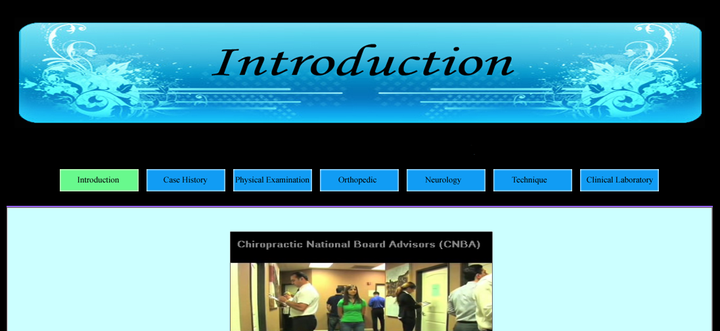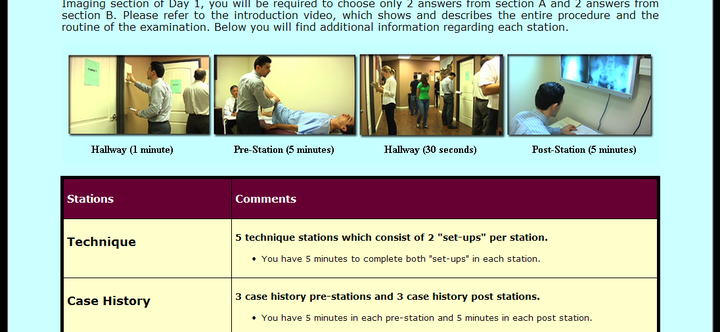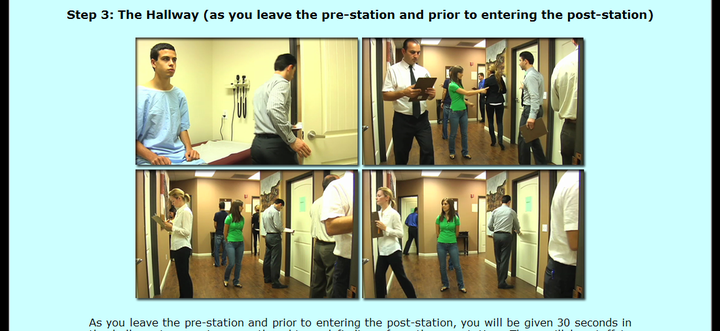Introduction to the Part IV Examination:
The Introduction section of the CNBA review describes the Part IV examination in detail and explains how the examination is administered. It takes you through the examination step by step and explains the process and the format of the examination. It also contains notes, samples of how the questions will be addressed, what is expected of you during the examination, and likely scenarios that may be presented. The Introduction section is very helpful and will allow you to understand exactly what is expected of you during the Part IV examination.
I. Diagnostic Imaging (DIM) aka X-ray
interpretation

1. Consists of 20 stations. You are given 2 minutes per station.
2. During the DIM portion, you will be viewing diagnostic images
on a monitor and answering two questions related to the images.
3. NBCE may also ask you to identify various types of special
imaging such as: MRI, CT, Ultrasound, etc.
II. Case Management

1. Consists of 20 stations. You will be given 5 minutes in each
station.
2. A pre-station is where the simulated patient will be. You
will be given 5 minutes for all of the pre-stations.
3. A post-station immediately follows the pre-station. At the
post-station, you will be required to answer questions regarding
the simulated patient's case from the pre-station. You will also
be given 5 minutes in all of the post stations.
4. The 20 stations consist of the following sections: Case
History, Orthopedic/Neurological, and Physical Examination. For
each of the sections listed below, you will be required to do
the following: a. Case History—Perform a brief focused case
history.
b. Orthopedic/Neurological—Perform a brief focused
Orthopedic/Neurological examination.
c. Physical Examination—Perform a brief focused physical
examination.
5. At each station you will be required to perform/choose one or
more of the following:
a. Choose the most likely diagnosis and/or clinical impression.
b. Choose the most appropriate case management procedure.
c. Choose the neurological signs most likely to be present. 6.
You will have the opportunity to perform the examinations on a
patient who has been trained to simulate a clinical condition.
There will be an observing doctor of chiropractic in the same
room grading your performance.
7. Some stations will require you to interact with the observing
doctor and the notation (verbal component) will be written next
to the listed examination(s). When you see verbal component
written, your job will be to perform and explain the procedure
on the patient, and report your findings to the observing
doctor.
8. In the post-stations, there will be two sections (A and B),
and you will be required to select three of the “best” answers
from each section related to the case presented in the
pre-station. Additional clinical data regarding the patient will
be provided in all of the post stations.
III. Chiropractic Technique

1. Consists of 5 stations. You will have 5 minutes to fully
complete each station.
2. At each technique station, you will be given
listings/subluxations from the following regions of the body:
two cervical, two thoracic, two lumbar, two pelvic and two
extremity. The instructions will state the type of set-up you
would need to perform for each of the listings/subluxations.
Patient position, doctor hand contact, and segmental contact
will always be provided.
3. You will be required to “set-up” for each of these
listings/subluxations. This means you will not and should not
attempt to adjust the patient at any time during the examination
( You are only required to "set-up" on the patient).
4. At times, you may also be required to show static and or
motion palpation techniques and to describe joint-related
anatomical landmarks. For example: If a listing requires you to
set-up on the C7 spinous process, the observing doctor may ask
you to explain how you found the C7 spinous process.
5. You will be evaluated by an observing doctor (licensed
chiropractor).




